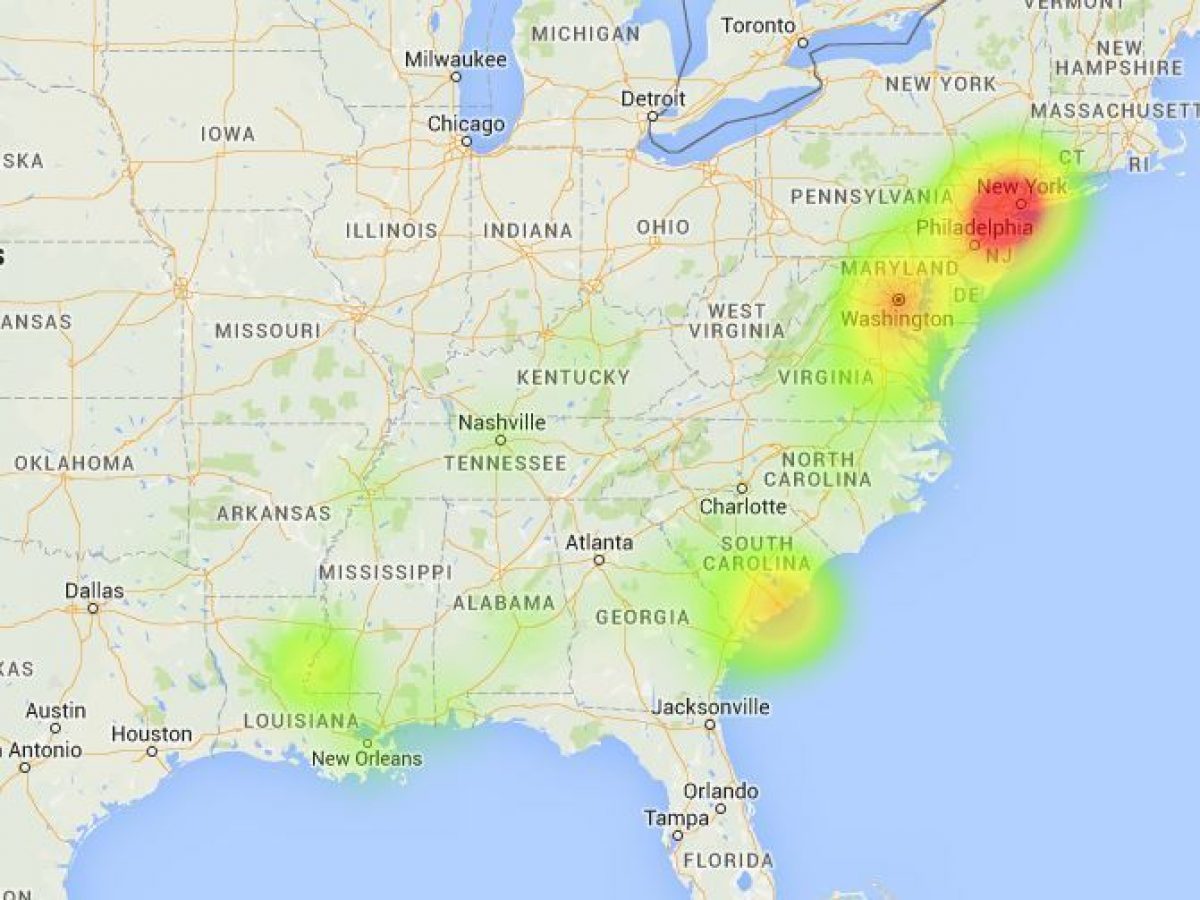Introduction
In order to understand Princeton’s relationship with slavery, it is important to consider how the nation at large perceived the College of New Jersey during the 18th and 19th centuries.
Southerners choosing a school for their sons would have been especially curious about the political climate on campus, and even those with no affiliation to the college would still know that Princeton educated the sons of elite families from across the country. Future governors, justices, clergymen (and a United States President) were educated at the College of New Jersey from before the American Revolution to the Civil War.
This exhibition explores the public image of the College of New Jersey through content published in newspapers. To what extent could the College of New Jersey control its image? Did a Princeton education imply a certain kind of politics? What did non-affiliates want to know about the school? By mapping the distribution of news about the College of New Jersey across the country, we can identify differing regional perceptions of the school between North and South.
Print culture in the 18th and mid-19th century differed from modern media in a number of respects. The bulk of the newspapers in this story are political or commercial in nature. The former reported on political news, often with an explicit link to one political party or another. Commercial papers were geared specifically toward the business and mercantile elite.[1] “Penny papers,” cheap newspapers that catered to a wider audience, were not a popular form of information until about 1833.[2]
Many newspapers received information about Princeton through exchanges with the Princeton Whig or other New Jersey publications. Princeton faculty, students, and alumni were also active in submitting news items to papers directly—though it is not always possible to determine the source of a particular news item in a paper.
The map below illustrates the sample of advertisements used in this story, mostly gathered from America’s Historical Newspapers but also including advertisements from local historical societies and the Chronicling America database. It is not intended to be a comprehensive list of newspaper references of Princeton. Several factors complicate the results, including the limitations of optical character recognition (OCR) technology, the limited number of digitized newspapers, and the simple fact that some contemporary papers have not been preserved in any form. However, the data available does demonstrate that Princeton news regularly appeared in Charleston (South Carolina), Mobile (Alabama), and other Southern cities.
Princeton in the News
News about Princeton, its alumni, and its students appeared in print throughout the country in a variety of forms, including: advertisements, obituaries, catalogues, Commencement notices, fundraising appeals, and occasionally reports of campus events.
Advertisements
Many Princeton graduates went on to establish educational institutions around the country. Alumni who founded schools in Southern states often used their connection to Princeton as an advertising tool, including endorsements from College of New Jersey faculty members in their promotional materials.
Local college preparatory schools based in Princeton also advertised to Southern students in order to attract more people to their schools and the College of New Jersey itself—the Edgehill School, for example, placed advertisements extensively in Southern newspapers.
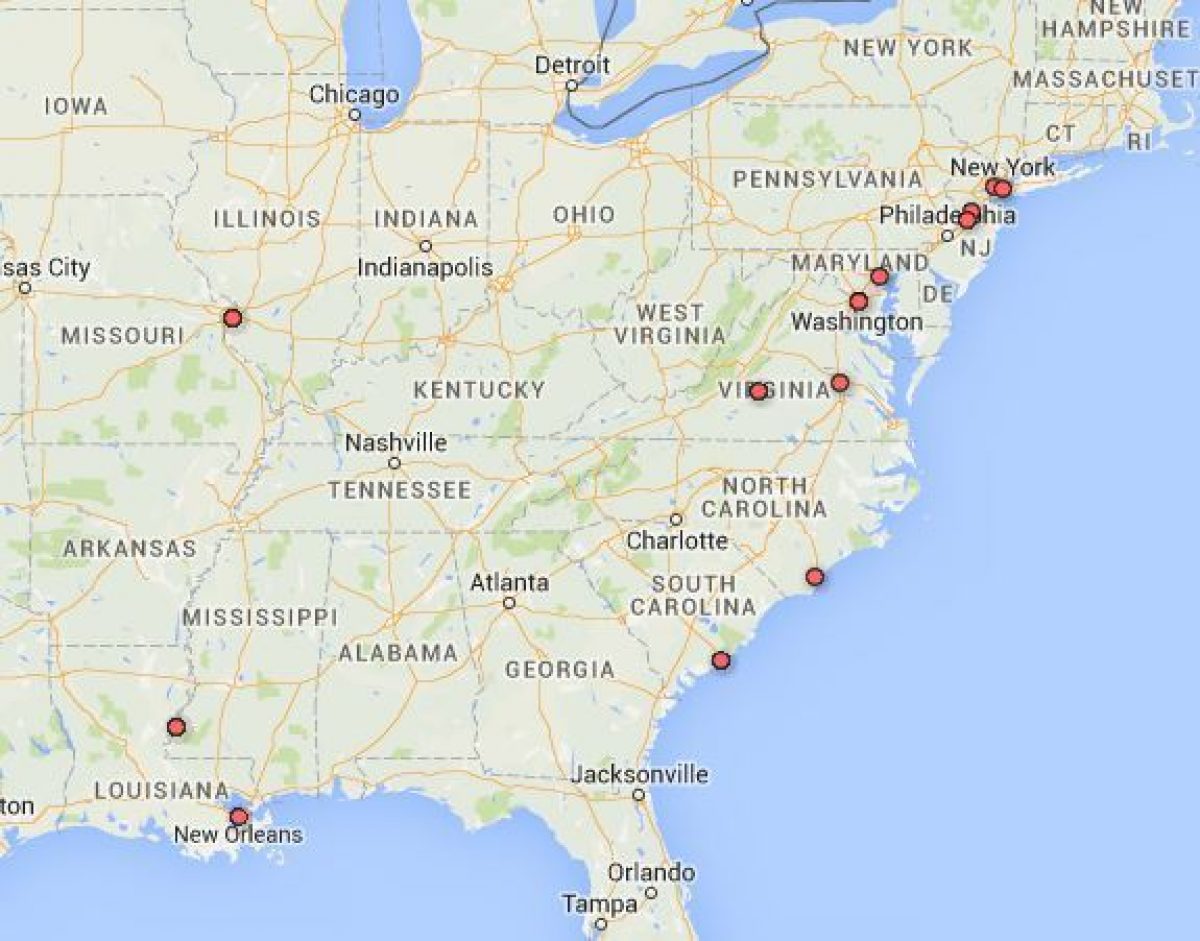
A map identifying where Edgehill advertisements were found throughout the country.
View Primary Sources
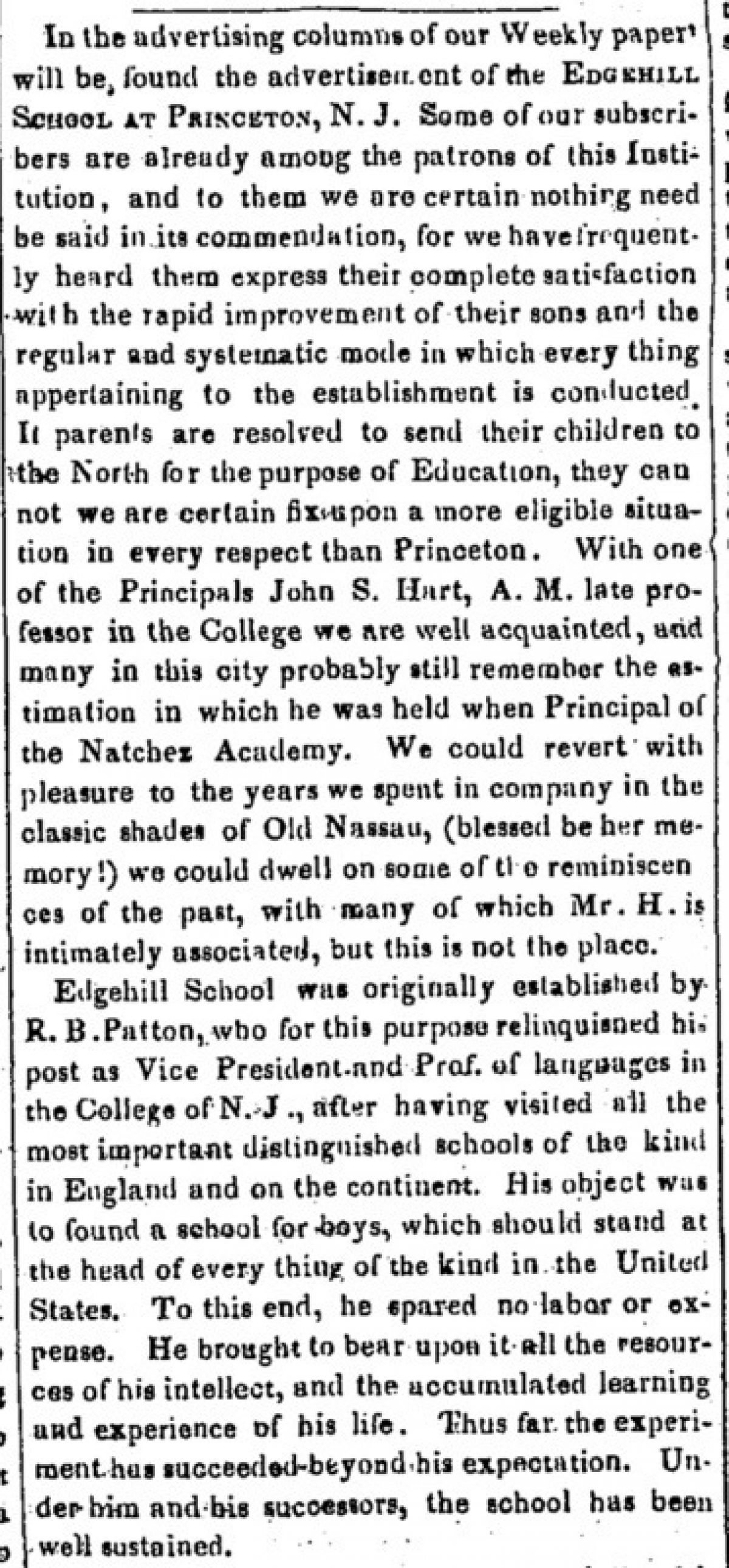
An advertisement for the Edgehill School in the Natchez Daily Courier, printed in Natchez, Mississippi, in 1836.
View Primary Sources
Obituaries
In addition to regular obituaries published in New Jersey papers for College of New Jersey graduates, the Whig and Clio societies occasionally published special memorials in the hometown newspapers of their deceased classmates.
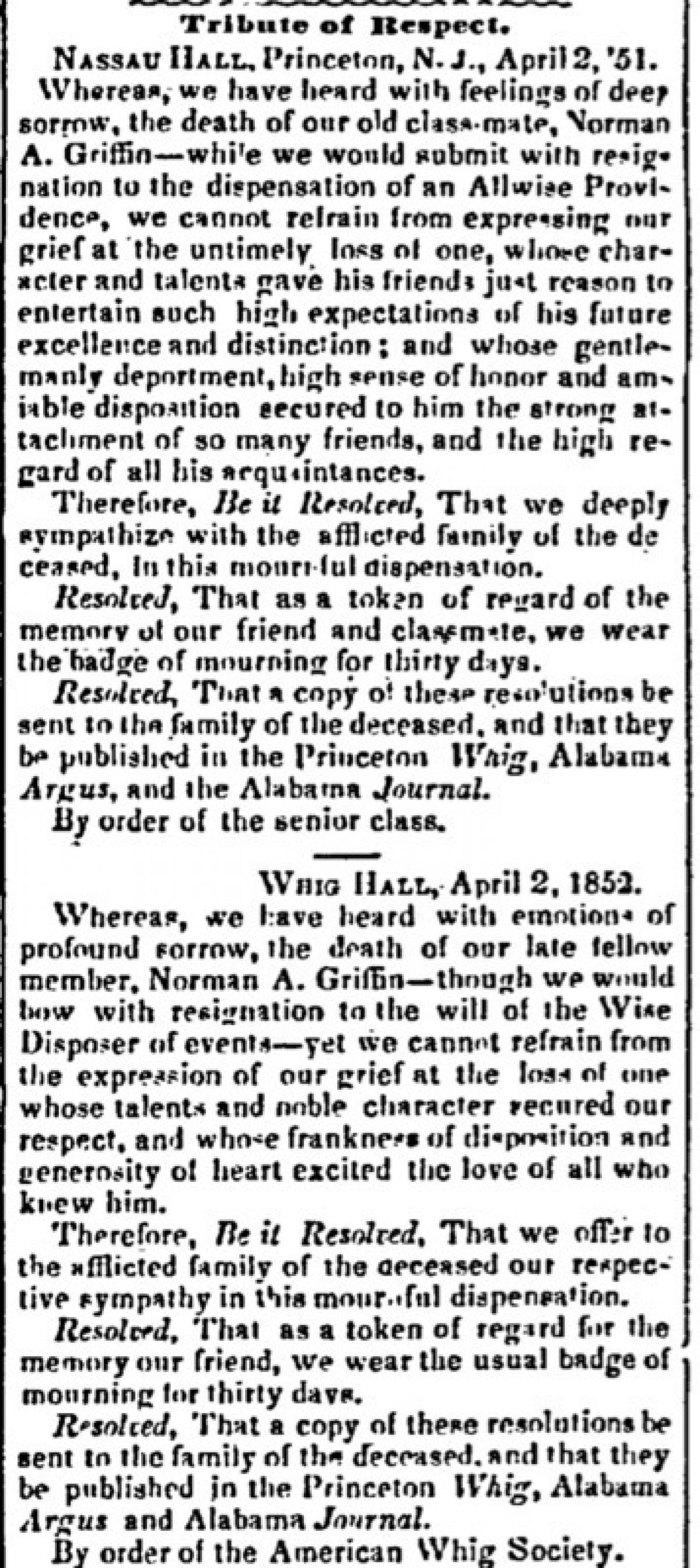
A statement of regret on the part of the Whig and Clio societies over the death of one of their members, Norman A. Griffin, printed in a Montgomery newspaper in 1852.
View Primary Sources
Catalogues
Another important source of information about Princeton were the catalogues printed and distributed by the college. Newspapers received catalogues from Princeton students or reprinted them from other papers. A catalogue mentioned in the Charleston Courier on 7 May 1856 listed the number of students from Southern states in each year of study at Princeton.

A catalogue printed in the Charleston Courier on May 7, 1856 listed the number of students from Southern states in each year of study.
View Primary Sources
Commencement Notices
The College of New Jersey's annual Commencement ceremonies were particularly well-reported events. The names and home states of graduating students, as well as the subject of commencement addresses, were printed regularly throughout the country. If the topic of the Commencement address was of special interest, newspapers would also print a summary of its contents.

A program for a College of New Jersey Commencement printed in a Charleston newspaper in 1800.
View Primary Sources
Fundraising College trustees' efforts to raise money also occasionally made the newspapers, such as in 1802, when a fire destroyed Nassau Hall and the college mobilized to rebuild. New Jersey and New York newspapers printed an appeal from President Samuel Stanhope Smith, whose call for subscriptions included a request to send news of the fire further South—an indication of the high numbers of Southerners among Princeton alumni. The lack of a similar request to Northern newspapers reflects the relatively low population of New Englanders at the school.

An announcement published by the trustees after the 1802 fire at Nassau Hall, including a request by President Samuel Stanhope Smith to send the advertisement to Southern newspapers.
View Primary Sources
Campus Events At times, conflicts on campus reached the papers. This was the case in January of 1817, when a group of Princeton students boarded up the doors of Nassau Hall, broke windows and harassed professors in an alarming riot.[3] One student wrote a letter about the incident, which was published in newspapers throughout the South. President Ashbel Green responded with another letter, which also circulated throughout Virginia, the Carolinas, and Georgia. Coverage of the riot generally singled out Southern students as the ringleaders, although several reports mentioned Northern students as well.

A letter from President Ashbel Green rebutting previously published stories of the riots at Princeton.
View Primary Sources
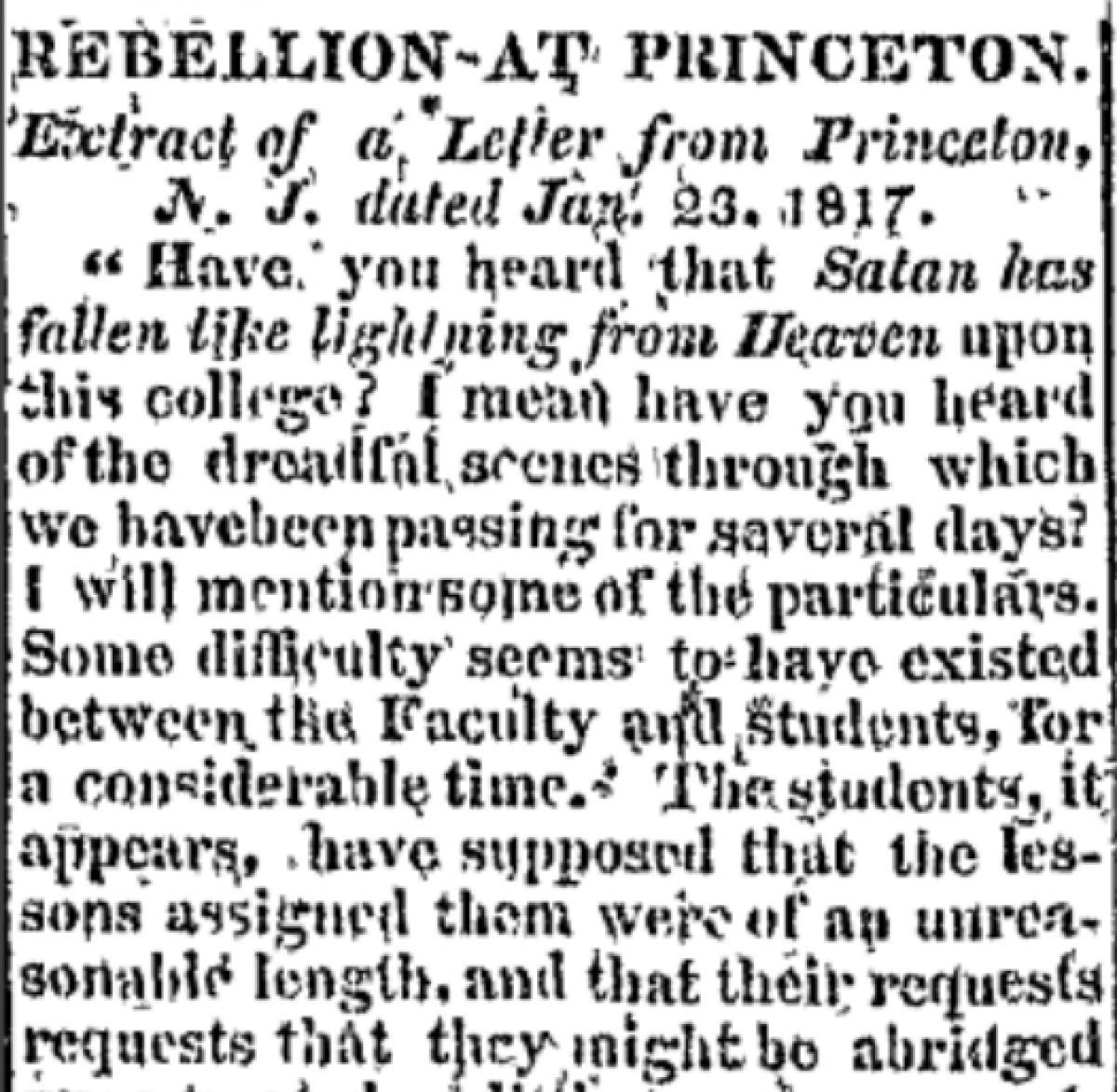
A letter from Princeton detailing the 1817 riots, published in an Alexandria newspaper.
View Primary Sources
Effigy-Burning of 1859
On December 3, 1859, a group of students paraded through campus carrying and ultimately burning effigies of abolitionist figures John Brown, William Seward, and Wendell Phillips—a reflection of mounting sectional tensions across the nation. The parade made national news, with many publications picking up the story from the Philadelphia Bulletin (an original copy of which could not be found). But as the story spread, newspapers published in different geographical regions of the country editorialized on the event, placing Princeton students' politics along a spectrum from moderately conservative to radically anti-abolitionist.
The notice printed in the Baltimore Sun on December 8th represents the standard account of the event. Virginia's Richmond Whig printed an expanded version of the story which emphasized the role of students over professors—presenting the College of New Jersey as a community of anti-abolitionists. Other newspapers, such as the Columbian Register of New Haven, framed the students as immature radicals. Two South Carolina newspapers, the Yorkville Enquirer and the Edgefield Advertiser, most likely received the story from the same source: the Carolinian. They contextualized reports of the activity on the college’s campus with similar instances of student unrest.
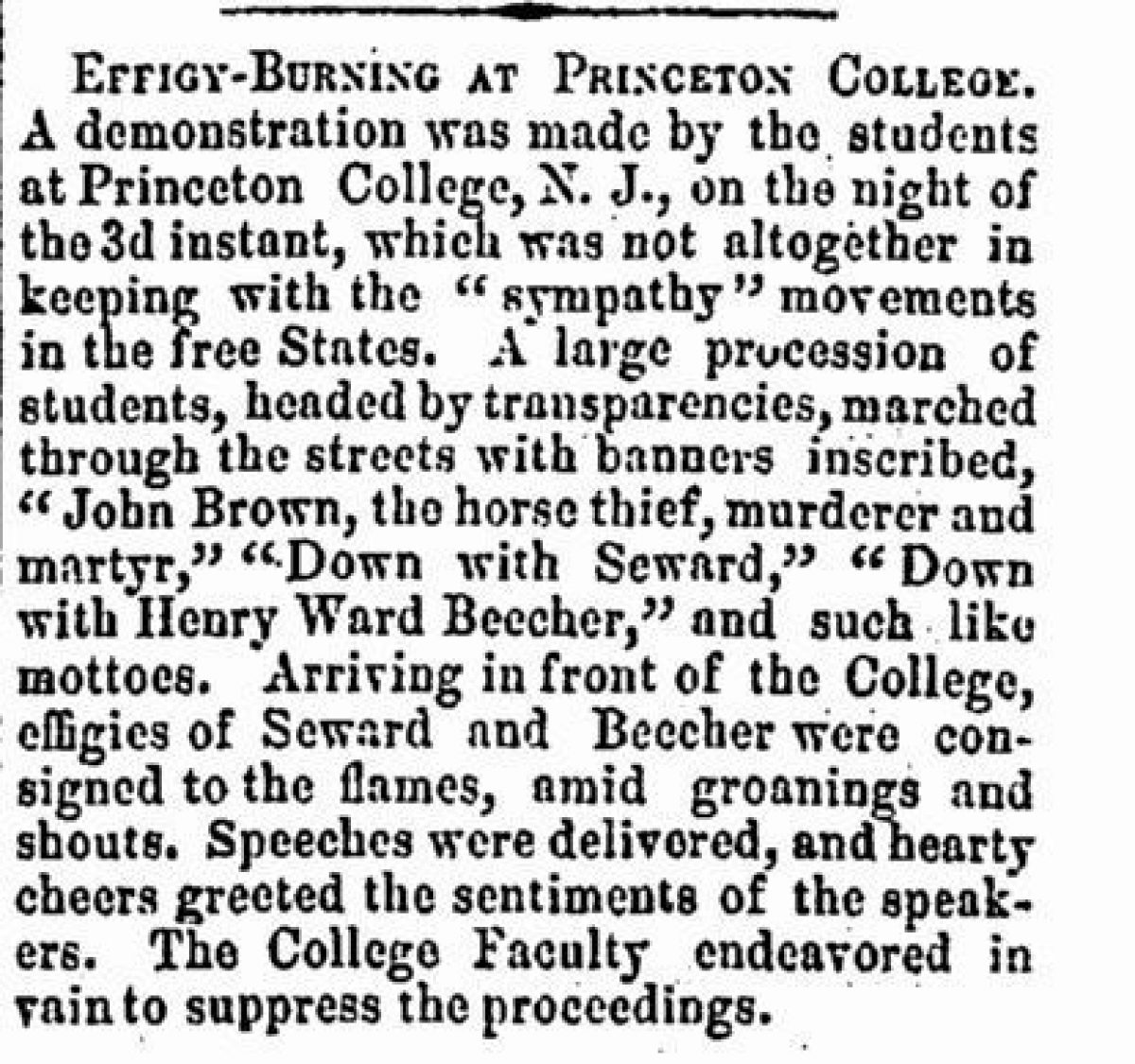
A news item about the burning of John Brown in effigy at the College of New Jersey, printed in the Baltimore Sun.
View Primary Sources
One student sent in his own account of the parade, clarifying that the students involved were not exclusively Southern and countering the print media's imposition of sectional divisions on the student body. He considered it important to present the college community as more moderate and unified than reported:
A Maryland student at Princeton (N.J.) College, writing to the ‘Worcester County (Md.) Shield’...says it is true that the students carried through the town in procession, the effigies of Seward, Beecher, and Wendell Phillips, and that the effigies were burned in front of North College; but a large part of the crowd was composed of Northern men from New York, Pennsylvania and New Jersey. It was not an outburst of Southern feeling; but the expression of disapprobation on the part of liberal students from all sections...Speeches...were moderate.[4]

A news item about the burning of John Brown in effigy at the College of New Jersey, printed in the Richmond Whig in Richmond, Virginia.
View Primary Sources

A response to the burning of effigies at the College of New Jersey, printed in the Columbian Register of New Haven, Connecticut.
View Primary Sources
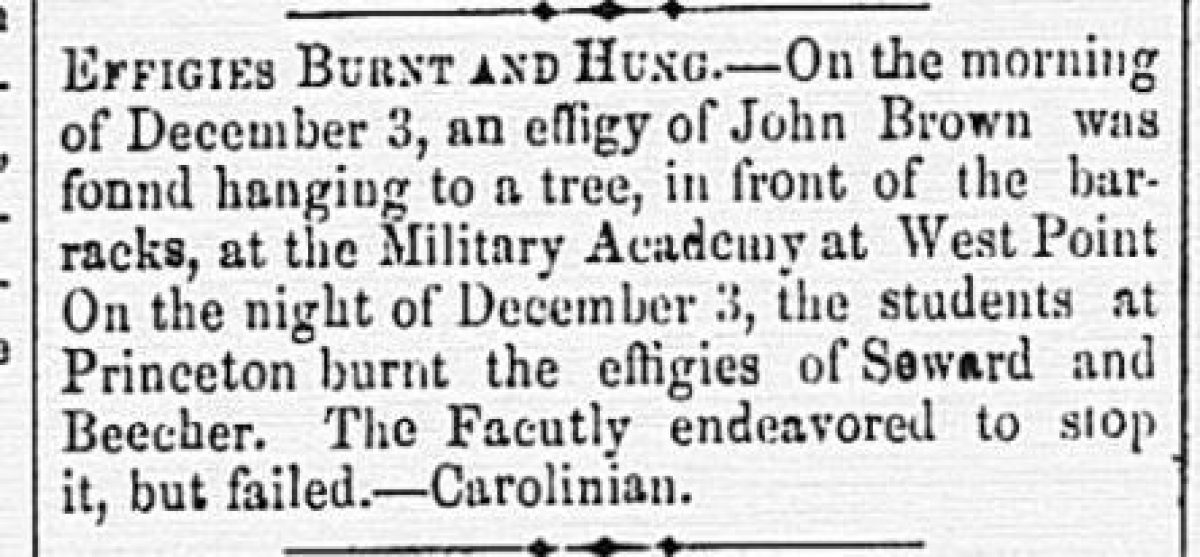
A news item about the burning of John Brown in effigy at the College of New Jersey printed in the Yorkville Enquirer in South Carolina.
View Primary Sources

A news item about the burning of John Brown in effigy at the College of New Jersey, printed in the Edgefield Advertiser in South Carolina.
View Primary Sources
References
[2]
Carol S. Humphrey, The Press of the Young Republic, 1783-1833 (Westport, CT: Greenwood Press, 1996), xiiv.
⤴
[3]
Thomas J. Wertenbaker, Princeton, 1746-1896 (Princeton, NJ: Princeton University Press, 1996), 167.
⤴
[4]
“News item”, Princeton Alumni Weekly, 7 April 1909, 406.
⤴




